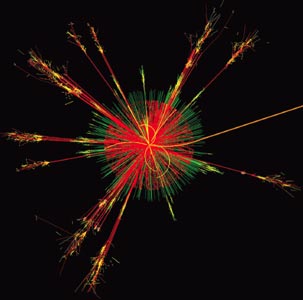Recent theoretical results have overturned the long-held notion that information cannot escape from a black hole, explains Seth Lloyd

You wake up in a hospital bed feeling a little groggy but otherwise okay. All your bits and pieces seem to be present, but you have no idea why you are there. The last thing you remember was waking up in the morning in your own bed at home and looking out of your window to find nothing but a black void. To your dismay, you realized that overnight your house had been swallowed by a black hole – an object so dense that not even light can escape from it. You remember saying to yourself “uh oh” as you looked up to find that you were plunging directly towards the singularity at the centre of the hole, where the density of matter and energy become infinite and all known laws of physics break down. Then you remember beginning to feel queasy as the tidal forces induced by the intense gravitational field of the hole began to tear you apart.
Settling back into your hospital bed, you feel relieved that the whole episode was just a bad dream. But that still does not explain what you are doing there. Just then, a doctor comes to your rescue. “One of our space ambulances found a black hole that was evaporating,” she states. “In accordance with the Hippocratic oath, which requires us to help anyone who might have fallen into a black hole, we collected the radiation that was emitted as the hole evaporated. By carefully decoding the information contained in that radiation, we were able to reconstruct you in the state you were in before you were sucked into the singularity.”
“But that’s impossible!” you yell. “I thought nothing could escape from a black hole – not even light.”
While fictional, this futuristic scene serves to highlight of one of the most important questions in physics: can information escape the gravitational pull of a black hole? For almost two centuries people have thought the answer was “no”, but recent research has forced us to revise this view.
A chequered history
The idea that any object could be so dense that light cannot escape from it was proposed by the English clergyman John Michell in 1783. A decade later, the great French mathematician Marquis Pierre Simon de Laplace used Newton’s laws of gravitation to calculate just how dense a star would have to be for this to occur. If light is made of particles, Laplace reasoned, they could move at a velocity less than the escape velocity for the star. So, just like a rock thrown from the surface of the Earth, light could be insufficiently speedy to escape the star’s gravitational field. Then in the early 20th century, the German physicist Karl Schwarzschild used Einstein’s general theory of relativity to identify the point of no return beyond which nothing can ever escape the pull of gravity: the “event horizon”. In Einstein’s theory, space actually curves around to prevent light, or anything else, from escaping.

But in the 1970s, glimmerings began to emerge that suggested something might be able to escape from a black hole after all. These glimmerings arose from the study of quantum mechanics, the branch of physics that describes things at their smallest scales. In 1974 Stephen Hawking of Cambridge University in the UK, building on earlier work by Jacob Bekenstein at the Hebrew University of Jerusalem, showed that when you include quantum mechanics in the description of the quantum fields surrounding a black hole, the hole is not entirely black. Instead, it appears to radiate particles into its surroundings. These particles constitute what became known as Hawking radiation and, crucially, they demonstrated that a black hole can evaporate.
Hawking’s work was immediately seen as a major breakthrough, being the first precise application of quantum mechanics to black holes. Hawking originally said that the radiation emerging from a black hole was completely random and therefore contained no useful information about the stuff inside the hole. This led to a famous wager in 1997 between Hawking and Kip Thorne of Caltech on one side and John Preskill of Caltech on the other: Hawking’s view was that information could not escape, while Preskill bet that it could. Two years ago, however, Hawking conceded that he was wrong and paid up, offering Preskill an encyclopedia of baseball in accordance with the terms of the original bet!
A question then arises: if the radiation emitted by a black hole is random, how is it possible to recover the information encoded in it? Returning to your unfortunate predicament in a hospital bed, how were the medical staff able to reassemble your constituent electrons, protons and neutrons to retrieve you from the random particles emerging from the black hole?
Vacuum rules
In order to understand how information can escape from a black hole, we first need to know what causes a black hole to radiate in the first place. In quantum mechanics, empty space is not really empty at all but full of pairs of “virtual” particles that suddenly spring in and out of existence. The particles appear in pairs because the vacuum contains no electric charge. So if a virtual electron, which has a negative charge, appears, then it must do so in conjunction with its antiparticle – a positively charged, virtual positron. In quantum mechanics, such perfectly anticorrelated states are said to be entangled, which means that the state of one particle completely determines the state of the other.
Near the event horizon of a black hole, virtual particle–antiparticle pairs are being created all the time. Every now and then, half of one of those pairs falls into the hole and cannot get out to recombine with its partner. If the partner outside the hole has sufficiently high energy, it can escape the gravitational pull of the hole and thus create the illusion that the hole is radiating. Entanglement then demands that the partner that does not escape the black hole has negative energy. Because of Einstein’s relation between mass and energy, E = mc2, the negative-energy partner effectively has a negative mass, so when it falls into the hole it causes the mass of the hole to decrease.
As the black hole evaporates, what happens to the information that it contains? It has been known since the latter part of the 19th century that every elementary particle contains information. Information is measured in “bits”, which represent the distinction between two possibilities: yes or no, true or false, 0 or 1. Photons, for example, can be polarized such that their electric field oscillates vertically or horizontally. If we identify horizontal polarization with a “0” and vertical polarization with a “1”, the polarization of the photon registers a bit of information.
Hawking’s original mechanism suggested that no information about what is going on inside the hole escapes during the evaporation process. But that mechanism does not take into account what happens inside the hole. Beyond the event horizon both the original matter that formed the black hole, which hurtles inexorably to the singularity at its centre, and the in-falling, negative-energy Hawking radiation are present.
At first, you might think that what happens to the matter inside the black hole has nothing to do with the Hawking radiation that has already escaped. In 2003, however, Gary Horowitz of the Institute for Advanced Study in Princeton and Juan Maldacena of Harvard University showed that whether or not information escapes from the hole depends on what kind of weird quantum events happen inside the hole (J. High Energy Phys. 0402 008). In particular, they reasoned, it depends on what happens at the singularity.
Journey to the centre of nothing
The singularity at the centre of a black hole is a strange and extreme place, where the energy density is apparently infinite and where the known laws of physics are almost certain to break down. At the singularity, space–time essentially ceases to exist, and all the information and quanta that inhabit it must therefore cease to exist too. At first it might therefore seem that all bets are off at the singularity – how can we even speculate about what happens when the laws of physics break down?
Well, that depends on just how badly those laws break down. At the singularity, something (i.e. particles or information) turns into nothing (i.e. no space or no time). That sounds bizarre, but we already have some experience where something (Hawking radiation) arises out of nothing (the vacuum). When something arises out of nothing, the laws of conservation of charge, spin and energy imply that the things that arose are entangled particle–antiparticle pairs. But suppose that the same laws still hold for the reverse process, so that the only way that something can turn into nothing is if that something also consists of entangled particle–antiparticle pairs.
Next, suppose that a particle of the in-falling Hawking radiation meets up at the singularity with a particle of the matter that formed the black hole in the first place. Let us assume that the only way in which these two particles can turn into nothing is to be in an entangled state – that is, the particle of matter that formed the hole is the opposite of the particle of Hawking radiation with which it hits the singularity. That particle of Hawking radiation is itself the opposite of the particle of outgoing Hawking radiation with which it was created. But the opposite of the opposite is the same. In other words, the particle of matter that formed the hole and the particle of outgoing Hawking radiation must have exactly the same properties.
When Horowitz and Maldacena proposed this mechanism for escape from black holes, Preskill, along with Daniel Gottesman of the Perimeter Institute in Canada, raised doubts about whether it could work (J. High Energy Phys. 0403 026). The Horowitz–Maldacena mechanism, they pointed out, was fragile because it required that the state in which incoming matter and Hawking radiation are annihilated at the singularity takes a highly specific form. Earlier this year, however, the present author showed that entanglement-induced escape from a black hole is robust after all: almost every single bit of information escapes (Phys. Rev. Lett. 96 061302).
The reason for this robustness lies again in the counterintuitive properties of entanglement. Almost all quantum states are within half a bit of what is called their maximal entanglement: their pieces are highly correlated. Applied to the Horowitz–Maldacena mechanism, the ubiquitous nature of entanglement implies that for almost all possible states in which the incoming matter and Hawking radiation can be annihilated, almost all the information in the incoming matter escapes from the black hole, albeit in a processed form. So if you do ever find yourself lying in a hospital bed having just been rescued from a black hole, you can rest assured that the laws of physics do not in themselves prevent you from an almost full recovery.
Fanciful as the notion of escaping from a black hole might seem, it is conceivable that black-hole evaporation could be probed experimentally. Under certain circumstances it might be possible, for example, to create miniature black holes in particle accelerators such as the Large Hadron Collider at CERN. In this case, the amount of information that escapes from a black hole could be measured experimentally.
From a theoretical point of view, the intimate connection between the evaporation of a black hole and entanglement suggests that a solution to the outstanding problem of finding a quantum theory of gravity may be found in the burgeoning field of quantum information. Until such experimental and theoretical investigations have been performed, however, you might want to hold off from jumping into a black hole.



